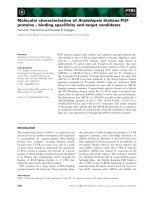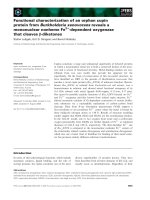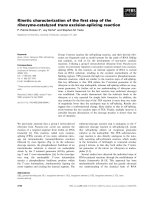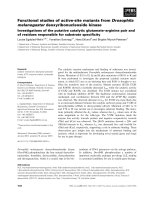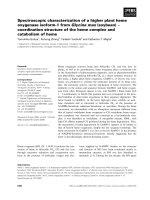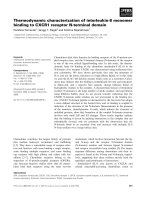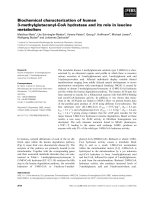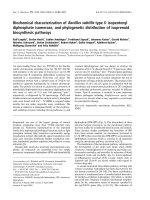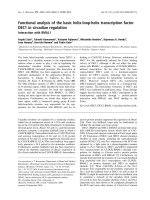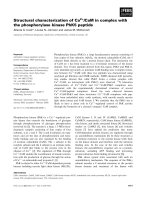Báo cáo khoa học: Functional characterization of ecdysone receptor gene switches in mammalian cells docx
Bạn đang xem bản rút gọn của tài liệu. Xem và tải ngay bản đầy đủ của tài liệu tại đây (546.61 KB, 14 trang )
Functional characterization of ecdysone receptor gene
switches in mammalian cells
Siva K. Panguluri
1
, Prasanna Kumar
2
and Subba R. Palli
1
1 Department of Entomology, College of Agriculture, University of Kentucky, Lexington, KY, USA
2 RheoGene Inc., Norristown, PA, USA
Inducible expression of transgene is desirable for var-
ious applications such as functional genomics, gene
therapy, therapeutic protein production and tissue
engineering [1–4]. Many laboratories have designed a
number of gene switches to achieve inducible expres-
sion. However, many of these systems have their own
advantages and disadvantages, such as differences in
background, levels of induction, as well as unpredicta-
bility of their performance in vivo, mainly because of
the inadequate understanding of molecular mecha-
nisms of their function in vivo.
An insect hormone receptor based gene regulatory
system, ecdysone receptor (EcR) gene switch, is gain-
ing popularity due to its low background activity in
the absence of ligand, and high inducible expression in
the presence of synthetic nonsteroid ligands that have
shown very good safety profiles (as reviewed in [1]).
The EcR is a member of the nuclear receptor super-
family [2] which is composed of N-terminal A ⁄ B
domain, the DNA binding C domain, the D domain
(hinge region), ligand binding E domain, and C-ter-
minal F domain. EcR heterodimerizes with other
Keywords
ChIP assay; EcR; gene switch; RXR; RNAi
Correspondence
S. R. Palli, Department of Entomology,
College of Agriculture, University of
Kentucky, Lexington, KY 40546, USA
Fax: +1 859 323 1120
Tel: +1 859 257 4962
E-mail:
(Received 15 August 2006, revised 5
October 2006, accepted 18 October 2006)
doi:10.1111/j.1742-4658.2006.05545.x
Regulated expression of transgene is essential in basic research as well as
for many therapeutic applications. The main purpose of the present study
is to understand the functioning of the ecdysone receptor (EcR)-based gene
switch in mammalian cells and to develop improved versions of EcR gene
switches. We utilized EcR mutants to develop new EcR gene switches that
showed higher ligand sensitivity and higher magnitude of induction of
reporter gene expression in the presence of ligand. We also developed
monopartite versions of EcR gene switches with reduced size of the compo-
nents that are accommodated into viral vectors. Ligand binding assays
revealed that EcR alone could not bind to the nonsteroidal ligand,
RH-2485. The EcR’s heterodimeric partner, ultraspiracle, is required for
efficient binding of EcR to the ligand. The essential role of retinoid X
receptor (RXR) or its insect homolog, ultraspiracle, in EcR function is
shown by RXR knockdown experiments using RNAi. Chromatin immuno-
precipitation assays demonstrated that VP16 (activation domain,
AD):GAL4(DNA binding domain, DBD):EcR(ligand binding domain,
LBD) or GAL4(DBD):EcR(LBD) fusion proteins can bind to GAL4
response elements in the absence of ligand. The VP16(AD) fusion protein
of a chimera between human and locust RXR could heterodimerize with
GAL4(DBD):EcR(LBD) in the absence of ligand but the VP16(AD) fusion
protein of Homo sapiens RXR requires ligand for its heterodimerization
with GAL4(DBD):EcR(LBD).
Abbreviations
AD, activation domain; Cf, Choristoneura fumiferana; ChIP, chromatin immunoprecipitation; DB, Drosophila ⁄ Bombyx; DBD, DNA binding
domain; Dm, Drosophila melanogaster; EcR, ecdysone receptor; GE, GAL4:CfEcR; GST, glutathione S-transferase; Hs, Homo sapiens; LBD,
ligand binding domain; Lm, Locusta migratoria; RE, response element; RXR, retinoid X receptor; USP, ultraspiracle.
5550 FEBS Journal 273 (2006) 5550–5563 ª 2006 The Authors Journal compilation ª 2006 FEBS
nuclear receptors [1], noticeably with ultraspiracle
(USP), an orthologue of the vertebrate retinoid X
receptor (RXR). EcR functions as a ligand controlled
transcription factor, which makes it a suitable constitu-
ent of gene switches. The main advantage of EcR gene
switches in mammalian system is that the ecdysteroids,
which are used to induce the switch, are structurally
different from mammalian steroids, and they are not
expected to bind to vertebrate steroid receptors. More-
over, humans eat large amounts of phytoecdysteroid-
containing vegetables without any detrimental effects
[3]. Many versions of EcR gene switches were devel-
oped in different laboratories to achieve high degree of
induction.
Initially, Christopherson et al. [4] transfected a
HEK293 cell line with Drosophila melanogaster EcR
(DmEcR) and a reporter gene to test various ecdyster-
oids and vertebrate steroids. Ponasterone A and Mur-
esterone A (MurA) were active and MurA could also
induce reporter gene when used with estrogen response
element (RE). No et al. [5] used constructs for fusion
protein containing N-terminal truncation of DmEcR
attached to the VP16 activation domain and complete
human RXRa and achieved 212-fold induction with
low basal activity. This EcR gene switch was shown to
function in mammalian cells and mice. Later, Suhr
et al. [6] reported high level transactivation of reporter
gene in the absence of RXR by using Bombyx mori
EcR with MurA or tebufenozide. Hoppe et al. [7]
developed a hybrid Drosophila ⁄ Bombyx ecdysteroid
receptor (DB-EcR) which has positive aspects of both
receptors and independent of recombinant RXR and
found to be efficient in both in vitro and in vivo applica-
tions. The expression of EcR and RXR in a bicistronic
vector [8] further improved EcR-based gene switches.
Although these versions of EcR-based switches have
several desirable characteristics, they have high basal
activity which causes low fold induction. Recently Palli
et al. [9] developed a bipartite format of EcR-based
inducible system by using the DEF domains of Choris-
toneura fumiferana EcR (CfEcR) fused to GAL4 DNA
binding domain (DBD) and VP16 activation domain
(AD) fused to Mus musculus RXR ligand binding
domain [MmRXR(EF)]. This version of EcR gene
switch supported nearly 9000-fold induction of reporter
gene by 48 h after treatment of a diacylhydrazine lig-
and (1 lm RG-102240). This switch was reported to
have good performance in stable cell lines as well as in
mouse tumors [10]. Recently, Palli et al. [11] and
Karzenowski et al. [12] reported further improvements
to the bipartite EcR gene switch. The current versions
of bipartite EcR gene switch have very low background
activity of reporter gene in the absence of ligand and
are activated by subnanomolar concentrations of lig-
and. One concern about this system for in vivo applica-
tions is the use of RXR, which is involved in large
number of metabolic pathways.
In the light of the potential use of this EcR gene
switch for in vivo applications such as gene therapy,
understanding the mechanism of functioning of this
switch in a mammalian system and improving the switch
to reduce any potential pleiotropic effects are therefore
necessary. The data presented here showed that the use
of two mutant versions of EcR (EcRtvy and EcRtvay)
increased ligand sensitivity of EcR gene switch. EcR
gene switch in a monopartite format containing a fusion
protein of VP16 activation domain, GAL4 DNA bind-
ing domain and the EcR DEF domains supported
ligand inducible reporter activity levels that are higher
than those supported by the other versions of EcR gene
switches reported so far. We also discovered that EcR
fusion proteins require heterodimeric partner for bind-
ing to ligand as well as for transactivation of reporter
genes in cells. An EcR gene switch that includes a fusion
protein containing VP16 activation domain, GAL4
DNA binding domain and EcR DEF domains and a
chimera containing helices 1–8 from human RXR
(HsRXR) and helices 9–12 from locust (Locusta migra-
toria; LmRXR) supported lower background levels of
reporter activity in the absence of ligand, higher indu-
cible levels of reporter activity in the presence of ligand,
and high ligand sensitivity. We analyzed the DNA bind-
ing, ligand binding, heterodimerization and transactiva-
tion properties of the switch components by chromatin
immunoprecipitation (ChIP) assay, RNAi and other
methods to understand the mechanisms of the switch
function in mammalian cells.
Results
Monopartite EcR gene switches
In order to develop a gene switch system with reduced
size of the components while retaining the low back-
ground and robust induction levels; we constructed
monopartite versions of EcR gene switches. Such a
system will be useful for incorporation into viral vec-
tors, particularly adeno-associated viral vectors where
the insert size is a major constraint. For this purpose,
we developed VGE, GVE and GEV monopartite for-
mats (Fig. 1A) by fusing VP16 activation domain with
different truncations of GAL4 DNA binding domain
(amino acids: 1–147, 1–93 and 1–65) and EcR
(CDEF ⁄ DEF), and performed transactivation experi-
ments in 3T3 cells. The results clearly showed that in
VG(147)E format (Fig. 2A) containing GAL4 DBD
S. K. Panguluri et al. Functional characterization of EcR gene switches
FEBS Journal 273 (2006) 5550–5563 ª 2006 The Authors Journal compilation ª 2006 FEBS 5551
(147) and EcR(CDEF) showed highest induction levels
(a maximum fold induction of 481 at 25 lm ligand
concentration). The VG(93)E format with GAL4 DBD
(amino acids: 1–93) also showed good induction levels
but were less than VG(147)E. The VG(65)E format
switch showed the lowest induction levels and very low
basal activity. The VG(65)E(CDEF) format switch
showed highest fold induction (706-fold) at 25 lm con-
centration of ligand. Similar results were observed with
the GVE format switch (Fig. 2B) except with higher
background expression of reporter gene than that
observed for VGE format switch. The initial versions
of GEV format switches were made by replacing
helix 12 of EcR with VP16 activation domain. This
version of GEV supported constitutive expression of
reporter gene expression in the absence of ligand (data
not shown). We then modified GEV format switch to
include helix 12 of EcR and this version supported
ligand inducible reporter activity (see below).
To understand the variation in the performance of
monopartite switch in different cell lines, we tested the
VGE version in four different cell lines, HEK293,
A
B
Fig. 1. (A) Schematic diagram of constructs used in various experiments. (B) Chemical structures of ligands used in various experiments.
Functional characterization of EcR gene switches S. K. Panguluri et al.
5552 FEBS Journal 273 (2006) 5550–5563 ª 2006 The Authors Journal compilation ª 2006 FEBS
CHO, NIH 3T3 and CV1. Clear differences among
four cell lines in induction levels as well as fold
induction were observed (Fig. 3). The 3T3 cells showed
less basal expression in the absence of ligand and
therefore high fold induction when compared to the
other three cell lines. To determine if the difference in
the induction levels of reporter gene by EcR gene
switch is due to the differences in levels of HsRXR iso-
forms, we transfected 3T3 cells with G:EcR(DEF) with
V:HsRXRa or V:HsRXRb or V:HsRXRc and the
transfected cells were exposed to various concentra-
tions of RG-102240. As shown in Fig. 4, G:EcR(DEF)
in combination with RXRc or RXRb showed similar
induction levels and these levels are higher than the
induction levels supported by G:EcR(DEF) and
V:HsRXRa combination.
Mutant EcRs improve the ligand sensitivity of
both bipartite and monopartite EcR gene
switches
We tested the two mutant versions of CfEcR, EcRtvy
(T335V, V390I and Y410E), EcRtvay (T335V, V390I,
A393P and Y410E), along with RXR chimera (a chi-
mera containing helices 1–8 from HsRXR and helices
9–12 from LmRXR) in NIH ⁄ 3T3 cells. The gene
0
0 0 0 0 1
0 0 0 0 2
0 0 0 0 3
0
0 0 0 4
0 0 0 0 5
0 0 0 0 6
0 0 0 0 7
0
0.04
0.2
1
5
25
0
0.04
0.2
1
5
25
0
0.04
0.2
1
5
25
0
0.04
0.2
1
5
25
0
0.04
0.2
1
5
25
0
0.04
0.2
1
5
25
V ) F E D ( E ) 7 4 1 ( G V
) F E D C ( E ) 7 4 1 ( G V
) F E
D
( E ) 5 6 ( G V ) F E D C ( E ) 5 6 ( G V ) F E D ( E ) 3 9 ( G
V
) F E D C ( E ) 3 9 ( G
Normalised RLU
1 8 4
4
7 1
A
0 1 3
6 0 7 7 4
9 4
) 1 . 7 (
) 4 9 (
) 1 9 (
) 7 2 2 (
) 5 0 1 (
) 6 2
(
B
0
0 0 0 5
0
0 0
0
1
0 0 0 5 1
0 0 0 0 2
0 0
0
5
2
0
0 0
0
3
) F E D ( E V ) 7 4 1 ( G ) F
E
D
C (
E
V
) 7 4 1 ( G ) F
E D
( E V )
3 9
( G ) F E D C (
E
V ) 3 9 ( G ) F
E
D ( E V ) 5 6 (
G
) F E D
C
( E V ) 5 6 ( G
Normalised RLU
8 . 7
4 . 7
6 . 1
2
7 2
3
4
8 2
)
3
1 6
1 (
) 3 6 3 2 (
) 1 8 8 (
) 9 4 1
(
)
0 3 5
(
)
7
4 5 (
0
0.04
0.2
1
5
25
0
0.04
0.2
1
5
25
0
0.04
0.2
1
5
25
0
0.04
0.2
1
5
25
0
0.04
0.2
1
5
25
0
0.04
0.2
1
5
25
Fig. 2. (A) Induction of luciferase reporter gene by monopartite switches. (A) Plasmid DNA samples of VP16(AD):GAL4(DBD)(1–147):EcR(C-
DEF) [VG(147)E(CDEF)] or VP16(AD):GAL4(DBD)(1–147):EcR(DEF) [VG(147)E(DEF)] or VP16(AD):GAL4(DBD)(1–93):EcR(CDEF) [VG(93)E(C-
DEF)] or VP16(AD):GAL4(DBD)(1–93):EcR(DEF) [VG(93)E(DEF)] or VP16(AD):GAL4(DBD)(1–65):EcR(CDEF) [VG(65)E(CDEF)] or
VP16(AD):GAL4(DBD)(1–65):EcR(DEF) [VG(65)E(DEF)] and pFRLuc were transfected into 3T3 cells using superfect lipid reagent. The trans-
fected cells were grown in the medium containing 0, 0.04, 0.2, 1, 5 and 25 l
M concentrations of RG-102240. The cells were harvested at
48 h after adding ligand, and the reporter activity was measured using luciferase assay kit from Promega. Total relative light units (RLU)
presented are mean ± SD (n ¼ 3). Numbers above the bars represents the maximum fold induction observed for that particular combi-
nation. The numbers in the parenthesis represent the RLU of the reporter activity in cells that exposed to dimethylsulfoxide (no ligand).
(B) Plasmid DNA samples of GAL4(1–147):VP16:EcR(CDEF) [G(147)VE(CDEF)] or GAL4(1–147):VP16:EcR(DEF) [G(147)VE(DEF)] or GAL4(1–
93):VP16:EcR(CDEF) [G(93)VE(CDEF)] or GAL4(1–93):VP16:EcR(DEF) [G(93)VE(DEF)] or GAL4(1–65):VP16:EcR(CDEF) [G(65)VE(CDEF)] or
GAL4(1–65):VP16:EcR(DEF) [G(65)VE(DEF)] and pFRLuc were transfected into 3T3 cells using superfect lipid reagent. The transfected cells
were grown in the medium containing 0, 0.04, 0.2, 1, 5 and 25 l
M concentrations of RG-102240. The cells were harvested at 48 h after add-
ing ligand, and the reporter activity was measured. The RLU presented are mean ± SD (n ¼ 3). Numbers above the bars represents the
maximum fold induction observed for that particular combination. The numbers in parentheses represents the RLU of the reporter activity in
cells exposed to dimethylsulfoxide (no ligand).
S. K. Panguluri et al. Functional characterization of EcR gene switches
FEBS Journal 273 (2006) 5550–5563 ª 2006 The Authors Journal compilation ª 2006 FEBS 5553
switches containing mutant EcR EcRtvy induced
reporter activity to much higher levels at 0.2 lm con-
centration of ligand when compared to those suppor-
ted by wild-type (wt) EcR (Fig. 5). For example, at
0.2 lm RG-102240, EcRtvy switch showed 2226-fold
induction of the reporter activity compared to 1133-
fold and 1313-fold induction supported by EcRtvay
and wild-type EcR gene switches, respectively. These
differences in the induction of reporter activity were
evident even at a higher concentration (5 lm)of
ligand. The gene switches containing mutant EcRtvy
supported high fold induction of reporter activity
(4917-fold) compared to the other mutant EcRtvay
(4316-fold) or wtEcR (4621-fold) at 5 lm RG-102240
(Fig. 5). Similar differences in the activity of EcRtvy,
EcRtvay and wtEcR gene switches were observed in
HEK293 cells (data not shown).
The monopartite gene switch format consists of the
DEF domains of mutant CfEcR (EcRtvy and
EcRtvay), GAL4 DNA binding domain and VP16
activation domain. Various combinations of the EcR
ligand binding domain, VP16 activation domain and
GAL4 DNA binding domain were constructed
(Fig. 1A) and tested in NIH ⁄ 3T3 cells. Out of six
combinations tested, VGEtvy (VP16:GAL4:EcRtvy)
showed the highest level of induction (1289-fold) in
cells treated with 5 lm RG-102240 (Fig. 6A). The
reporter gene induction was dose dependent and signi-
ficant levels of reporter gene induction were observed
even at lower concentration (0.2 lm) of RG-102240.
The VGEtvay (VP16:GAL4: EcRtvay) also showed
dose dependent induction with maximum induction of
53-fold in cells treated with 5 lm RG-102240 (Fig. 6B).
The low levels of induction in VGEtvay, when com-
pared to the VGEtvy, are not only due to low levels of
induced reporter activity but also due to high back-
ground activity in the absence of ligand. Although the
0
005
0001
0051
00
02
0052
000
3
0053
0
0.1
1
5
10
50
0
0.1
1
5
10
50
0
0.1
1
5
10
50
0
0.1
1
5
10
50
3T3
1V
COHC
3
92
Normalised RLU
5
4
1
222
951
506
)3.8()5()8.21()3.9(
Fig. 3. NIH ⁄ 3T3 cells showed high induction levels of reporter
gene. The plasmid DNA samples of VP16:GAL4:EcR(DEF) [VGE]
and pFRLuc were transfected into 293, CHO, CV1 and 3T3 cells
using superfect lipid reagent. The transfected cells were grown in
the medium containing 0, 0.1, 1, 5, 10 and 50 l
M concentrations of
RG-102240. The cells were harvested at 48 h after adding ligand,
and the reporter activity was measured and the RLU presented are
mean ± SD (n ¼ 3). Numbers above the bars represents the maxi-
mum fold induction observed for that particular combination. The
numbers in parentheses represents the RLU of the reporter activity
in cells that exposed to dimethylsulfoxide (no ligand).
0
00001
00002
00003
00004
00005
00006
00007
00008
0
0.1
1
5
10
50
0
0.1
1
5
10
50
0
0.1
1
5
10
50
Normalised RLU
56
72
4503
5554
)7.51()2.91()5.11(
RcE
:
G
RXR:
V
RcE:G
RXR:V
RcE:G
RXR:V
Fig. 4. The GAL4:EcR + VP16:RXRc switch showed higher induction
than the switches containing a and b isoforms of RXR. The plasmid
DNA samples of GAL4:EcR (GE) + VP16:HsRXRa ⁄ RXRb ⁄ RXRc and
pFRLuc were transfected into 3T3 cells using superfect lipid reagent.
The transfected cells were grown in the medium containing 0, 0.1, 1,
5, 10 and 50 l
M concentrations of RG-102240. The cells were har-
vested at 48 h after adding ligand. The reporter activity was meas-
ured and the RLU presented are mean ± SD (n ¼ 3). Numbers above
the bars represents the maximum fold induction observed for that
particular combination. The numbers in parentheses represents the
RLU of the reporter activity in cells exposed to dimethylsulfoxide (no
ligand).
0
0002
0004
0006
0008
000
0
1
00021
DMSO
0.2
1
5
DMSO
0.2
1
5
DMSO
0.2
1
5
RmL-sH:V+yavtE:G
Rm
L-sH:V+
y
vtE:
G
RmL-sH:V+Rc
E
:G
Normalised RLU
1264
)5.1(
)74
.1()2(
7194
6134
Fig. 5. Two mutant of CfEcR perform better than wild-type EcR.
Plasmid DNA samples of GAL4:CfEcR (GE) + VP16:Hs-LmRXR
(VHs-LmR) or GAL4:CfEcRtvy (GEtvy) + VHs-LmR or GAL4:CfEcRt-
vay (GEtvay) + VHs-LmR and pFRLuc were transfected into 3T3
cells using superfect lipid reagent. The transfected cells were
grown in the medium containing 0, 0.2, 1 and 5 l
M concentrations
of RG-102240. The cells were harvested at 48 h after adding ligand
and the reporter activity was measured. The RLU presented are
mean ± SD (n ¼ 3). Numbers above the bars represents the maxi-
mum fold induction observed for that particular combination. The
numbers in the parenthesis represents the RLU of the reporter
activity in cells exposed to dimethylsulfoxide (no ligand). DMSO,
dimethylsulfoxide.
Functional characterization of EcR gene switches S. K. Panguluri et al.
5554 FEBS Journal 273 (2006) 5550–5563 ª 2006 The Authors Journal compilation ª 2006 FEBS
GVE combinations GAL4:VP16:EcRtvy (GVEtvy)
and GAL4:VP16:EcRtvay (GVEtvay) showed high
sensitivity to the ligand (showed induced reporter
activity even at low concentrations of 0.02 lm RG-
102240), they were leaky, showing high background
expression of reporter gene in the absence of ligand.
The GEV combinations GAL4:EcRtvy:VP16 (GEtvyV)
and GAL4:CfEcRtvay:VP16 (GEtvayV) showed low
background in the absence of ligand, but they also
showed very low levels of reporter induction in the
presence of ligand (19.6-fold and 9.7-fold, respectively,
at 5 lm RG-102240 concentration). Thus, out of the
three formats of monopartite switches tested, VGE for-
mat appeared to perform better than GVE or GEV.
Out of the two mutants tested, EcRtvy showed the
highest ligand sensitivity, low background and high
levels of ligand-induced reporter expression.
EcR fusion proteins need heterodimeric partner
for ligand binding
To determine whether VGE fusion protein requires het-
erodimeric partner for binding to ligand, we performed
ligand binding assays. The glutathione S-transferase
(GST) fusion proteins of CfEcR DEF mutant (Etvy),
VGEtvy, GVEtvy, GEtvyV and CfUSP(A–F) proteins
were expressed in bacteria using GST expression vec-
tors and purified. Etvy, VGEtvy, GVEtvy and GEtvyE
alone or in combination with CfUSP were tested for
binding to [
3
H]RH-2485, a close analog of RG-102240
(Fig. 1B). As shown in Fig. 7A, [
3
H]RH-2485 showed
very little binding to Etvy, VGEtvy, GVEtvy and GEt-
vyE. However, in the presence of CfUSP, [
3
H]RH-2485
bound to all the four EcR proteins suggesting that EcR
requires the USP partner for its high affinity binding to
the ligand. We then determined the dissociation con-
stants (K
d
) of RH-2485 binding to Etvy + CfUSP and
VGEtvy + CfUSP. As shown in Fig. 7B,C, RH-2485
bound to Etvy + CfUSP and VGEtvy + CfUSP with
high affinity with K
d
values of 1.647 nm (confidence
interval of )0.5963 to 3.891, R2 of 0.9292, degree of
freedom of 10) and 1.447 nm (confidence interval of
0.9588–1.935, R2 of 0.9788, degree of freedom of 28),
respectively. These data showed that VGE fusion pro-
tein of EcR requires heterodimeric partner for binding
to the ligand.
Addition of RXR improves the performance
of monopartite gene switch
Because ligand binding assays showed that USP is
required for binding of ligand to EcR, we decided to
test whether RXR is required for efficient functioning
of VGEtvy switch. For this purpose we transfected
pFRLuc reporter, VGEtvy and one of the RXRs
(VHsRXR, VLmRXR or VP16 fusion of one of the
Hs-LmRXR chimeras) into NIH ⁄ 3T3 cells and the
transfected cells were exposed to various concentra-
tions of RG-102240. Chimeras 6, 8, 9 and VLmRXR
increased the performance of VGEtvy switch. Chimera
10, 11 and VHsRXR caused much lower enhancement
of VGEtvy switch when compared to VLmRXR or
VHs-LmRXR chimeras 6, 8, and 9 (Fig. 8A). Thus,
inclusion of VP16 fusion of one of the three chimeras
between HsRXR and LmRXR or LmRXR itself
caused substantial increase in the performance of
VGEtvy switch. Next, we wanted to determine whether
the presence of VP16 on both the receptors (VGEtvy
and VRXR) is responsible for the improvement in the
performance of VGEtvy switch in the presence of
VP16:RXR. VP16 domain was deleted from VHs-
0
2000
4000
6000
8000
10000
12000
DMSO
0.2
1
5
DMSO
0.2
1
5
DMSO
0.2
1
5
DMSO
0.2
1
5
G:EcRtvy+
V:Hs-LmR
VG
A
Etvy GVEtvy GEtvyV
Normalised RLUNormalised RLU
(2)
(3)
(522)
(3.7)
4917
1289
2.9
19.6
G:EcRtvay+
V:Hs-LmR
B
0
1000
2000
3000
4000
5000
6000
7000
8000
DMSO
0.2
1
5
DMSO
0.2
1
5
DMSO
0.2
1
5
DMSO
0.2
1
5
VGEtvay GVEtvay GEtvayV
(1.5) (36)
(1464)
(2.8)
4316
53
9.7
3
Fig. 6. Induction of luciferase gene by monopartite switches with
mutant EcRs. (A) Plasmid DNA samples of GEtvy + VHs-LmR or
VP16:GAL4:EcRtvy (VGEtvy) or GAL4:VP16:EcRtvy (GVEtvy) or
GAL4:EcRtvy:VP16 (GEtvyV) and pFRLuc were transfected into 3T3
cells using superfect lipid reagent. The transfected cells were
grown in the medium containing 0, 0.2, 1 and 5 l
M concentrations
of RG-102240. The cells were harvested at 48 h after adding ligand
and the reporter activity was measured and the RLU presented are
mean ± SD (n ¼ 3). Numbers above the bars represents the maxi-
mum fold induction observed for that particular combination. The
numbers in parentheses represents the RLU of the reporter activity
in cells exposed to dimethylsulfoxide (no ligand). (B) The experi-
ments and procedures used are same as in (A), except EcRtvay
mutant was used in place of EcRtvy mutant. DMSO, dimethylsulf-
oxide.
S. K. Panguluri et al. Functional characterization of EcR gene switches
FEBS Journal 273 (2006) 5550–5563 ª 2006 The Authors Journal compilation ª 2006 FEBS 5555
LmRXR chimera 9 and the construct was tested for its
ability to improve the performance of VGEtvy and
GEtvyV in NIH ⁄ 3T3 cells. As shown in Fig. 8B,
Hs-LmRXR with and without VP16 fusion protein
performed equally well in improving the performance
of both VGEtvy and GEtvyV switches. Similar results
were observed when Hs-LmRXR chimera 9 with
and without VP16 was compared as a partner for
VGEtvay and GEtvayV (Fig. 8C). Thus, RXR region
but not the additional VP16 domain is responsible for
improving the performance of VGEtvy and GEtvyV
switches.
VGE fusion proteins utilize endogenous RXR for
efficient transgene activation
The ligand binding experiments showed that the ligand
binding to EcR improved in the presence of USP. The
transactivation experiments showed that the VGE
fusion protein can support the reporter gene induction
in the absence of exogenously supplied RXR but the
reporter activity was higher in the presence of exogen-
ously supplied RXR chimeras. It is then possible that
the endogenous RXRs in the cells are binding to VGE,
enabling them to transactivate genes placed under their
control. We tested this hypothesis using double-stran-
ded RNA prepared against HsRXRa and HsRXRb.
Microarray analysis of gene expression in HEK293
cells showed that only HsRXRa and HsRXRb are
expressed in these cells and HsRXRc expression is not
detected (data not shown). HEK293 cells were trans-
fected with VGEtvy and pFRLuc or VGEtvy and
pFRLuc and double-stranded RNA for RXRa and
RXRb or bacterial malE gene. In cells transfected with
double-stranded RNA for HsRXRa and HsRXRb,
there was 3.5-fold decrease in induction of reporter
activity in the presence of RG-102240 when compared
to the reporter induction levels in the cells transfected
with malE double-stranded RNA or those that were
transfected with only VGEtvy and pFRLuc (Fig. 9A).
We have also performed a parallel experiment to deter-
mine the levels of RXR mRNA in the cells trans-
fected with double-stranded RNAs using quantitative
RT-PCR. The quantitative RT-PCR results showed
that there is not much difference in RXR levels in
maltose double-strand RNA treated and untreated
(positive control) cells, but a significant decrease in
RXR levels was observed in cells transfected with
RXR double-stranded RNAs. In these cells, the RXRa
showed 95.7% and the RXRb showed 78.5% knock-
down when compared to the levels in cells transfected
with malE double-stranded RNA (Fig. 9B). These data
suggest that VGE fusion proteins bind to endogenous
RXR and the EcR ⁄ RXR heterodimer binds to the
response elements and transactivates genes placed
under the control of the response elements.
Fig. 7. Ligand binding assay of EcR fusion proteins. (A) The GST
fusion proteins of CfEcR DEF tvy mutant (Etvy), VGEtvy, GVEtvy and
GEtvyV by themselves or in combination with GST fusion protein of
CfUSP were incubated with [
3
H]-labeled RH-2485 (0.000822 pmol) in
presence of excess RG-102240 (10 m
M). The unbound ligand was
removed by dextran coated activated charcoal treatment and radioac-
tivity in the supernatant was counted using liquid scintillation coun-
ter. The specific binding was expressed in disintegrations per minute
and the error bars shown are the standard deviation of three repli-
cates. (B,C) Saturation kinetics of the binding of [
3
H]-labeled RH-2485
to mutant CfEcRtvy + CfUSP (B) or CfEcRtvy fusion protein in mono-
partite format (VGEtvy) plus CfUSP (C). Specific binding (d) which is
the total binding (j) minus the nonspecific binding (m) and dissoci-
ation constants (K
d
) are displayed.
Functional characterization of EcR gene switches S. K. Panguluri et al.
5556 FEBS Journal 273 (2006) 5550–5563 ª 2006 The Authors Journal compilation ª 2006 FEBS
VGEtvy+
V:HsR
A
VGEtvy+
V:Hs-LmR 6
VGEtvy+
V:Hs-LmR 8
VGEtvy+
V:Hs-LmR 9
VGEtvy+
V:Hs-LmR 10
VGEtvy+
V:Hs-LmR 11
VGEtvy+
V:LmR
0
0005
0000
1
00051
00002
0005
2
DMSO
0.008
0.04
0.2
DMSO
0.008
0.04
0.2
DMSO
0.008
0.04
0.2
DMSO
0.008
0.04
0.2
DMSO
0.008
0.04
0.2
DMSO
0.008
0.04
0.2
DMSO
0.008
0.04
0.2
Normalised RLU
771
822
2131
7291
6.389
4141
)01()162()3.5()01()11()26()3.5(
B
VGEtvy VGEtvy+
V:Hs-LmR
VGEtvy+
Hs-LmR
GEtvyV+
V:Hs-LmR
GEtvyV+
Hs-LmR
0
0005
00001
00051
00002
00052
00003
000
5
3
DMSO
0.2
1
5
DMSO
0.2
1
5
DMSO
0.2
1
5
DMSO
0.2
1
5
DMSO
0.2
1
5
Normalised RLU
79
82
7152
5642
5
2
41
9821
)4.11()5.6()3
(
)6
.
3(
)
2.8
(
C
VGEtvay VGEtvay+
V:Hs-LmR
VGEtvay+
Hs-LmR
GEtvayV+
V:Hs-LmR
GEtvayV+
Hs-LmR
0
0002
0
004
0
00
6
0
00
8
00001
00021
00041
DMSO
0.2
1
5
DMSO
0.2
1
5
DMSO
0.2
1
5
DMSO
0.2
1
5
DMSO
0.2
1
5
Normalised RLU
83
4
9
0
3
921
08
3
35
)73(
)8
.5()04()04()4.12(
Fig. 8. Induction of luciferase gene by monopartite switches with different RXRs. (A) Plasmid DNA samples of VGEtvy + VP16:HsRXR
(HsR) or VGEtvy + VP16:Hs(1–6)-LmRXR(7–12) (V:Hs-LmR-6) or VGEtvy + VHs(1–8)-LmR(9–12) (V:Hs-LmR-8) or VGEtvy + VHs(1–9)-
LmR(10–12) (V:Hs-LmR-9) or VGEtvy + VHs(1–10)-LmR(11–12) (V:Hs-LmR-10 or VGEtvy + VHs(1–11)-LmR (12) (V:Hs-LmR-11) or VGEtvy
+ VP16:LmRXR (VLmR) and pFRLuc were transfected into 3T3 cells using superfect lipid reagent. The transfected cells were grown in
the medium containing 0, 0.008, 0.04 and 0.2 l
M concentrations of RG-102240. The cells were harvested at 48 h after adding ligand
and the reporter activity was measured and the RLU presented are mean ± SD (n ¼ 3). Numbers above the bars represent the maxi-
mum fold induction observed for that particular combination. The numbers in parentheses represent the RLU of the reporter activity in
cells that exposed to dimethylsulfoxide (no ligand). (B) Plasmid DNA samples of VGEtvy or VGEtvy + VHs-LmR or VGEtvy + Hs-LmR or
GEtvyV + VHs-LmR or GEtvyV + Hs-LmR and pFRLuc were transfected into 3T3 cells using superfect lipid reagent. The transfected
cells were grown in the medium containing 0, 0.2, 1 and 5 l
M concentrations of RG-102240. The cells were harvested at 48 h after
adding ligand and the reporter activity was measured and the RLU presented are mean ± SD (n ¼ 3). Numbers above the bars repre-
sent the maximum fold induction observed for that particular combination. The numbers in parentheses represent the RLU of the repor-
ter activity in cells that exposed to dimethylsulfoxide (no ligand). (C) The experiments and procedures used are the same as in (B)
except VGEtvay was used in place of VGEtvy. DMSO, dimethylsulfoxide.
S. K. Panguluri et al. Functional characterization of EcR gene switches
FEBS Journal 273 (2006) 5550–5563 ª 2006 The Authors Journal compilation ª 2006 FEBS 5557
GAL4:EcR fusion proteins bind to GAL4 response
element independent of ligand and RXR, but EcR
binding to HsRXR is ligand-dependent
It is not known whether GAL4:EcR (GE) fusion pro-
teins bind to GAL4 response element prior to or after
binding to ligand: ChIP assay was used to answer this
question. NIH ⁄ 3T3 cells were transfected with GEtvy +
VHs-LmRXR, GEtvy + VHsRXR, VGEtvy + VHs-
LmRXR, or VGEtvy + VHsRXR. The ligand,
RG-102240 (5 lm) was added to the cells at 4 h after
transfection and the cells were incubated for 48 h. The
transfected cells were fixed with formaldehyde accord-
ing to the manufacturer’s protocol (Active Motif, Car-
lsbad, CA, USA) and the sheared chromatin was
pulled down with anti-VP16 IgG for bipartite switches,
with anti-GAL4 IgG for monopartite gene switch com-
plex. An expected size PCR product was detected after
amplification using GALRE primers and the template
DNA eluted from cells transfected with VGE or GE
fusion protein constructs plus VHs-LmRXR fusion
protein constructs and exposed to either dimethylsulf-
oxide or RG-102240 and precipitated with GAL4 or
VP16 antibodies suggesting that the ligand is not
required for heterodimer of VGE or GE fusion pro-
teins and VHs-LmRXR binding to the GAL4 response
elements (Fig. 10; lane 1–8). In contrast, an expected
size PCR product was not detected when the template
DNA eluted from cells transfected with
GE + HsRXR and exposed to dimethylsulfoxide and
precipitated with VP16 antibodies was used as a tem-
plate (Fig. 10; lane 9). On the other hand, an expected
size PCR product was detected using the template
DNA from cells transfected with GE + VHsRXR and
exposed to ligand RG-102240 and precipitated with
VP16 antibodies. This suggested that VHsRXR can
heterodimerize with GE and the heterodimer binds to
GAL4 response elements only in the presence of ligand
(Fig. 10; lane 10).
0
0002
0004
0006
0008
00001
00021
00041
00061
DMSO
0.008
0.04
0.2
1
5
DMSO
0.008
0.04
0.2
1
5
DMSO
0.008
0.04
0.2
1
5
Elam +yvtEGVyvtEGV
A
NRs
D
RXR +yvtEGV
ANRsD
RLU
3
A
56
426
581
)8.91()1.3()91(
B
0
0
0
.0
001.0
0
02
.
0
003.0
004.0
0
0
5
.0
0
0
6.
0
0
0
7.
0
0
08.0
0
09
.
0
lortnoC E
la
m lortnoCi
A
NR Elam iANR
RXR α RXRsremirP β sremirP
Relative Expression
%7.59
%
5
.
8
7
Fig. 9. Endogenous RXR is involved in EcR gene switch function-
ing. (A) Plasmid DNA samples of VGEtvy or VGEtvy plus double-
stranded RNA for malE or VGEtvy plus double-stranded RNAs for
RXRa and RXRb and pFRLuc were transfected into HEK293 cells
using superfect lipid reagent. The transfected cells were grown in
the medium containing 0, 0.008, 0.04, 0.2, 1 and 5 l
M concentra-
tions of RG-102240. The cells were harvested at 48 h after adding
ligand and the reporter activity was measured and the RLU mean ±
SD (n ¼ 3) are presented. Numbers above the bars represents the
maximum fold induction observed for that particular combination.
The numbers in parentheses represents the RLU of the reporter
activity in cells that exposed to dimethylsulfoxide (no ligand).
DMSO, dimethylsulfoxide. (B) Plasmid DNA samples of VGEtvy or
VGEtvy plus double-strand RNA for malE or VGEtvy plus double-
strand RNAs for RXRa and RXRb were transfected into HEK293
cells using superfect lipid reagent. The cells were harvested for
RNA isolation after 48 h of transfection and normalized expression
levels of RNA were estimated through quantitative RT-PCR by
using RXRa and RXRb primers.
Fig. 10. The fusion proteins of GE and VGE bind to GAL4 RE in the
absence of ligand. HsRXR but not chimera between Hs-LmRXR
require ligand for heterodimerization with EcR. Analysis of the bind-
ing of switch components to response element in ChIP assay.
Lane1: VGEtvy(dimethylsulfoxide), lane 2: VGEtvy(RG-102240),
lane 3: VGEtvy + V:HsR(dimethylsulfoxide), lane 4: VGEtvy +
V:HsR(RG-102240), lane 5: VGEtvy + V:Hs-LmR(dimethylsulfoxide),
lane 6: VGEtvy + V:Hs-LmR(RG-102240), lane 7: GEtvy + V:Hs-
LmR(dimethylsulfoxide), lane 8: GEtvy + V:Hs-LmR(RG-102240), lane
9: GEtvy + V:HsR(dimethylsulfoxide) and lane 10: GEtvy +
V:HsR(RG-102240).The HEK293 cells were transfected with VGEtvy
or VGEtvy + V:HsR or VGEtvy + V:Hs-LmR or GEtvy + V:HsR or GEt-
vy + V:Hs-LmR and pFRLUC. dimethylsulfoxide or 5 l
M RG-102240
ligand was added to each combination after 4 h of transfection and
the cells were fixed with formaldehyde at 48 h after addition of lig-
and and precipitated with VP16 antibodies as described in Experi-
mental procedures. VP16 antibodies were able to precipitate DNA–
protein complexes for all combinations tested except the GEtvy +
V:HsR treated with dimethylsulfoxide (lane 9) suggesting that
V:HsRXR binds to GEtvy only in the presence of ligand.
Functional characterization of EcR gene switches S. K. Panguluri et al.
5558 FEBS Journal 273 (2006) 5550–5563 ª 2006 The Authors Journal compilation ª 2006 FEBS
Discussion
The most significant contributions of this study are
better understanding of the molecular mechanism of
EcR gene switches in mammalian cells and develop-
ment of an efficient EcR gene switch that showed low
background activity in the absence of ligand and high
induced activity in the presence of ligand. Many of the
current EcR switches are in bipartite format, which
requires RXR for efficient transactivation of the genes
placed under their control. Among these EcR switches,
the RheoSwitch
Ò
system display the lowest back-
ground activity coupled with a strong inducibility (up
to 10 000-fold) in cultured cells [11,12]. These switches
can be very good for applications where the size of the
switch components is not a concern. However, for cer-
tain applications in which the cells are sensitive to the
slightest perturbations in the metabolic pathways
involving RXR can be a drawback [13].
In order to find the best possible monopartite switch
format, we screened different formats of switches
VG(147)E(CDEF), VG(147)E(DEF), VG(93)E(CDEF),
VG(93)E(DEF), VG(65)E(CDEF) and VG(65)E(DEF)
that include VP16 activation domain and three differ-
ent truncations of GAL4 DNA binding domain (G147,
G93 and G65) and two different EcR truncations
(CDEF and DEF). Similar constructs were also made
in GVE and GEV formats. From the transactivation
experiments it was concluded that VGE is the best for-
mat for monopartite switch that showed high induction
levels which are dose responsive. Out of all VGE for-
mats tested, VG(65)E(CDEF) showed high fold induc-
tion (706-fold at 25 lm RG-102240) but with low
reporter activity when compared to the reporter levels
supported by other format switches. Although the
G(93) and E(CDEF) switch showed higher fold induc-
tions among all the VGE and GVE switches tested,
they are not preferred because of the concern that the
EcR DNA binding domain present in them may bind
to endogenous nuclear receptors and cause changes in
endogenous gene expression. The formats with G(147)
and E(DEF) were found to have high fold induction as
well as high induction levels, which can be useful for
developing an efficient monopartite switches for in vivo
studies.
To identify an efficient EcR monopartite switch, we
screened three formats of these switches that had acti-
vation domain, DNA binding domain and two differ-
ent mutant (tvy and tvay) EcR ligand binding domain
arranged in different orders (VGE, GVE and GEV).
All the three monopartite switch formats supported
ligand dependent transactivation of reporter gene acti-
vation. However, the performance of the VGE format
was the best as in the case of VGE format with wild-
type EcR. GVE format showed higher background lev-
els of induction in the absence of ligand and GEV
showed low induction levels as well as low background
expression of reporter gene. The differences in the per-
formance of these monopartite switches could be due
to the difference in ligand induced conformational
changes as well as displacement of corepressors and
recruitment of coactivators by EcR fusion proteins
upon addition of ligand. The placement of EcR relat-
ive to GAL4 and VP16 probably influence the
behavior of fusion protein upon binding to ligand.
Apparently, having activation domain (VP16) and
DNA binding domain (GAL4), in that order, on the
NH
2
-terminal end of EcR is better than the other two
formats. Interestingly, this is the arrangement in nat-
ural EcRs [activation domain A ⁄ B, DNA binding
domain (C) and ligand binding (E) domain].
The difference in induction levels between cell lines
were found when we transfected VGE monopartite
switch. The difference might be due to the difference
in the levels of endogenous RXR isoforms among cell
lines. This in turn can be explained by the results
obtained in the transfection experiments with G:CfEcR
with V:RXRa or V:RXRb or V:RXRc. The data
showed that the induction levels and fold induction are
higher in transfections containing V:RXRc rather than
with RXRa or RXRb. Our microarray data showed
that very low levels of cRXR in HEK293 cells, the iso-
form that supported higher induction levels. This could
be the possible reason for low induction levels
observed for reporter activity supported by EcR gene
switches in HEK293 cells when compared to 3T3,
CHO and CV1 cell lines. In addition to the difference
in levels of RXRs, it could also be due to difference in
levels of human carbon catabolite repressor protein
complex, which is reported to interact with RXR and
its heterodimers in ligand dependent manner and
represses its transactivation function [14].
There are very few reports on EcR-based monopar-
tite switches. Suhr et al. [6] developed a monopartite
switch by fusing B. mori ecdysone receptor CDEF
domains with VP16 activation domain. The luciferase
reporter gene was placed under the control of four tan-
dem repeats of EcREs inserted upstream of a thymi-
dine kinase gene minimal promoter. This switch was
reported to have high level of ligand induced transgene
expression without exogenous RXR. The present study
indicates that the endogenous RXR participates in the
functioning of this VP16-EcR gene switch. However,
the use of EcR DNA binding domain and EcRE raises
the possibilities of endogenous steroid receptors of the
host cells binding to the EcRE. Recently, Karzenowski
S. K. Panguluri et al. Functional characterization of EcR gene switches
FEBS Journal 273 (2006) 5550–5563 ª 2006 The Authors Journal compilation ª 2006 FEBS 5559
et al. [12] reported that monopartite gene switch VGE
that contained a mutant CfEcR (CfEcRvy) showed
higher background activity in the absence of ligand,
resulting in only four to nine-fold inductions. To
reduce the background activity in the absence of lig-
and. Fourteen different activation domains were tested
in place of VP16 and achieved a maximum induction
of 152-fold in NIH ⁄ 3T3 and 207-fold in HEK293 cells
exposed to 1 lm RG-102240.
In this study, we also compared the performance of
two mutant EcRs with high ligand sensitivity due to
three (T335V, V390I and Y490E) or four (T335V,
V390I, A393P and Y490E) mutations in the ligand
binding domain. EcRtvy binds to both steroids and
nonsteroids while EcRtvay binds to nonsteroids but
not to ecdysteroids ([15] and data not shown). Both
these mutants performed much better than the wild-
type EcR in both bipartite and monopartite switches.
EcRtvy performed better than EcRtvay, but because
of steroid insensitivity, EcRtvay may be useful for
applications where exposure to ecdysteroids may be a
problem. EcRtvy is one of the most efficient EcR
monopartite switches developed by the present work.
The ligand induced reporter activity supported by this
switch is as good as that reported for bipartite switch
[11]. However, background activity in the absence of
ligand is slightly higher than that of bipartite switch,
which needs improvement prior to widespread use of
this format in various applications.
Ligand binding assays showed that very little
[
3
H]RH-2485 bound to GAL4:EcR, VGE, GVE and
GEV fusion proteins. However, addition of USP
resulted in dramatic increase (between 7238 and
15 164-fold) in [
3
H]RH-2485 binding to these EcR
fusion proteins. Lezzi et al. [16] reported that extracts
of yeast cells expressing fusion protein of GAL4 actva-
tion domain and DmEcR showed low level binding to
[
3
H]ponasterone A and the specific binding increased
dramatically with the addition of USP. Similar obser-
vations were reported by Minakuchi et al. [17]. Our
RNAi experiments also clearly demonstrated the
requirement of RXR for efficient functioning of VGE
switch. Taken together, these observations clearly dem-
onstrate the requirement of heterodimeric partner for
efficient functioning of EcR.
As explained above, VGE fusion protein requires
USP or RXR for efficient ligand binding and transacti-
vation. If this is the case, addition of RXR should
improve the function of VGE switch. When VGE or
GEV construct was cotransfected with VP16:HsRX-
REF or VP16:LmRXR or a chimera between these two
RXRs, both VP16:LmRXR and chimeras 6, 8 and 9
increased both ligand sensitivity and ligand induced
reporter activity of EcR switch. VP16:HsRXR did not
cause much improvement in the performance of VGE
or GEV switches. This may be due to the fact that
these switches already use endogenous RXR and addi-
tional RXR does not improve their performance.
VP16:LmRXR and the chimeras between HsRXR and
LmRXR heterodimerize more efficiently with EcR than
does HsRXR [11], therefore these receptors are able to
improve switch performance. Our data also showed
that it is the RXR but not the additional VP16
domains present in VP16:RXR that is responsible for
improvement in the performance of these switches. The
ligand sensitivity of VGE + Hs-LmR is similar to the
sensitivity of bipartite switch, GE + V:Hs-LmRXR.
But, the induction levels of VGE + Hs-LmRXR
switch are higher when compared to those of bipartite
switch GE + V:Hs-LmRXR. The major advantages of
these new versions of VGEtvy + Hs-LmRXR and
VGEtvay + Hs-LmRXR switches are the following:
(a) because of use of mutant EcRs, ligand sensitivity of
these switches is much higher than the earlier versions
of EcR gene switches, (b) VGEtvay + Hs-LmRXR
switch can be used in applications in which potential
exposure to plant derived ecdysteroids could be a con-
cern, and (c) the removal of VP16 activation domain
from Hs-LmRXR chimera reduces the chances of inter-
ference with endogenous gene expression due to poten-
tial interaction of V:Hs-LmRXR with endogenous
nuclear receptors. The major disadvantage of this
VGEtvy + Hs-LmR switch is the slightly higher back-
ground activity in the absence of ligand when com-
pared to earlier versions of EcR bipartite switches.
Further modifications are needed to reduce the back-
ground activity of this switch.
The results from ChIP assay showed that VGE and
GE can bind to GAL4 response elements in the
absence of ligand. Hs-LmRXR can heterodimerize
with GE in the absence of ligand. In contrast, HsRXR
can bind to GE only in the presence of ligand. The
ChIP assay using anti-VP16 IgG suggests that
EcR ⁄ Hs-LmRXR can heterodimerize in the absence of
ligand. On the other hand, EcR ⁄ HsRXR requires lig-
and for their heterodimerization. These data support
our earlier findings using pulldown assays that EcR
can interact with Hs-LmRXR in the absence of ligand
but needed ligand to pull down HsRXR [11]. These
findings indicate that it may be possible to modify
EcR such that it no longer binds to endogenous
HsRXR even in the presence of ligand. Creation of an
EcR mutant that no longer requires binding of het-
erodimeric partner for its high affinity binding to
ligand may become more attractive choice for applica-
tions in vivo.
Functional characterization of EcR gene switches S. K. Panguluri et al.
5560 FEBS Journal 273 (2006) 5550–5563 ª 2006 The Authors Journal compilation ª 2006 FEBS
In summary, the research described here contribu-
ted to the development of an improved version of
EcR gene switch with more desirable properties than
the earlier versions. These studies also contribute to
understanding the function of EcR gene switch in
mammalian cells, particularly the role of RXR or
USP in the EcR function. This in turn should help in
designing more improved EcR gene switches in the
future.
Experimental procedures
Constructs
To make VGE, pM vector (Clonetech Inc., Palo Alto, CA,
USA) carrying DEF domains of CfEcR [9] was used as a
template to amplify GAL4:CfEcR (GE) with restriction
sites SalI on the 5¢ end and NotI on the 3¢ end, and the
PCR product was cloned into pACT vector (Promega,
Madison, WI, USA). Similarly, to make GVE, the CfEcR
was excised with restriction sites BamHI and XbaI from
pM vector and cloned in pACT vector. This pACT vector
containing EcR DEF domain was used as a template to
amplify VP16:CfEcR (VE) with restriction sites SalIon5¢
end and Not I on the 3¢ end and cloned into pBIND vector
(Promega). We have also prepared VG(93)E, VG(65)E,
G(93)VE and G(65)VE with truncated GAL4 DBD (amino
acids: 1–93 and 1–65). VGEtvy, GVEtvy, VGEtvay and
GVEtvay were prepared by replacing KpnI fragment in the
E domain of CfEcR with the KpnI fragments from CfEcR
containing T335V, V390I and Y410E mutations (tvy) and
T335V, V390I, A393P and Y410E mutations (tvay). To pre-
pare GEtvyV and GEtvayV, CfEcR DEF domains were
amplified using VGEtvy and VGEtvay as a templates using
primers containing restriction sites BamHI on the 5¢ end
and HindIII on the 3¢ end and VP16AD encoding 44 amino
scids from pVP16 with restriction sites HindIII on the
5¢ end and NotI on the 3¢ end, and these fragments
were cloned in pBIND vector (Promega). Construction of
VP16:HsRXR (a fusion between VP16 activation domain
and Homo sapiens RXR EF domains, VHsRXR),
VP16LmRXR (a fusion between VP16 activation domain
and Locusta migratoria RXR EF domains, VLmRXR) and
Chimeras between human and locust RXR (VHs-LmRXR)
used here have been described previously [11]. Hs-LmRXR
chimera without VP16 AD (Hs-LmRXR) was prepared by
PCR amplifying RXR chimera using primers containing
EcoRI and XbaI restriction sites and cloning into the same
sites in pACT (Promega). All constructs were assembled by
standard cloning methods and confirmed by DNA sequen-
cing. Inducible luciferase reporter plasmid pFRLuc contain-
ing five copies of the GAL4 response element (5· GALRE)
and synthetic minimal promoter was purchased from Strat-
agene Cloning Systems (La Jolla, CA, USA).
Transient transfections
NIH ⁄ 3T3 and HEK293 cells were maintained at 37 °C with
5% CO
2
in DMEM supplemented with 10% fetal bovine
serum and 1% penicillin ⁄ streptomycin (Invitrogen, CA,
USA). One day before transfection, cells were plated in
48-well plates at a density of 12 500 cellsÆwell
)1
. On the sec-
ond day, the medium from the plates were replaced with
100 lL of fresh serum free DMEM and the cells were
transfected with 63 ng of receptor constructs and 250 ng of
reporter construct pFRluc using SuperFect lipid (Qiagen
Inc., Valencia, CA, USA) according to manufacturer’s
instructions.
A second reporter, Renilla luciferase, expressed under a
thymidine kinase constitutive promoter was cotransfec-
ted into cells and used for normalization. After 4 h of
transfection, 125 lL of DMEM containing 20% fetal
bovine serum and double the concentration of inducer,
RG-102240 also known as GS
TM
-E or RSL 1 was added.
Two days after transfection, the medium was discarded
and the cells were lysed in 50 lL passive lysis buffer
(Promega). Twenty microliters of extract were transferred
to 96-well opaque plates and the luciferase and Renilla
luciferase reporter activities were measured using the Dual
luciferase
TM
reporter assay system from Promega and
Fluoroskan Ascent FL (ThermoLab Systems, Helsinki,
Finland). All the transfection experiments were performed
in triplicate and the experiments were repeated at least
three times.
Ligand binding
To determine whether CfEcR in VGE, GVE and GEV
(with EcRtvy and EcRtvay mutants) format, needs heterod-
imeric partner to bind to ligand, VGE, GVE and GEV con-
structs were cloned in pGEX vector (Promega) in the sites
SalI and NotI and expressed in BL-21 Escherichia coli cells.
Fifteen milliliters of LB medium containing 50 lg ÆL
)1
amp-
icillin was inoculated and grown overnight at 30 °C. The
overnight cultures were diluted into 500 mL of LB medium
with 50 lgÆL
)1
ampicillin and grown to D
600
of 0.5. The
cells were induced with 100 lm isopropyl thio-b-d-galacto-
side for 3 h and harvested by centrifugation at 7700 g for
10 min at 4 °C (Eppendorf Microcentrifuge 5415D; Eppen-
dorf AG, Hamburg, Germany). The cell pellet was resus-
pended in NaCl ⁄ P
i
containing protease inhibitors, sonicated
and subjected to centrifugation at 12 000 g for 10 min at
4 °C (Eppendorf Microcentrifuge 5415D). The clarified
lysates were analyzed on a polyacrylamide gel and the pro-
teins were used for ligand binding assays. These conditions
have been previously used to determine the binding of EcRs
to ligands [18,19].
The proteins were prepared in T-buffer (10 mm Tris
pH 7.2 and 1 mm dithiothreitol) to a final volume of
S. K. Panguluri et al. Functional characterization of EcR gene switches
FEBS Journal 273 (2006) 5550–5563 ª 2006 The Authors Journal compilation ª 2006 FEBS 5561
100 lL with 0.1 lL (84 323 disintegrations per minute)
of
3
H RH-112485 [Methoxy-
3
H] with specific activity of
83 CiÆmmol
)1
and 99% pure (HPLC purified) is competed
with 10 mm RG-102240. A similar reaction mixture was
made for Scatchard analysis with 1 lL of different dilu-
tions of [
3
H]RH-112485. The reaction mixture was kept
at 4 °C for 4 h; the unbound [
3
H]RH-2485 was removed
by activated charcoal:dextran (10 : 1) and the bound
radioactivity was measured in liquid scintillation counter.
The background radioactivity was measured by adding all
the ingredients except proteins and was deducted from
the hot and cold values. The counts for liquid scintilla-
tion cocktail were also measured and were taken as refer-
ence or blank. The counts of the radioactive ligand alone
in the scintillation liquid cocktail were also measured and
these values were taken in the y-axis as total added. The
reactions were done in triplicate. The dissociation con-
stant, K
d
, was evaluated from the saturation curve for
radioligand binding using nonlinear regression analysis
with one site binding (hyperbola) equation in the graph-
pad prism program (GraphPad Software, San Diego, CA,
USA).
ChIP assay
To determine whether the receptor proteins need ligand to
bind to response element, ChIP assay was performed by
using ChIP-IT
TM
kit (Active Motif). HEK293 cells were
cultured in 5 mL DMEM with 10% fetal bovine serum
and the cells were transfected with GEtvy:VHs-LmRXR,
GEtvy:VHsRXR, VGEtvy alone, VGEtvy:VHsRxR and
VGEtvy:VHs-LmRXR. The transfected cells were exposed
to dimethylsulfoxide or 5 lm RG-102240 for 48 h. Then
the cells were fixed with formaldehyde and collected by
scraping with rubber policeman and centrifuged at 510 g
for 10 min at 4 °C (Eppendorf Microcentrifuge 5415D).
The cells were homogenized and the chromatin was
sheared by using enzyme cocktail for 30 min. The sheared
chromatin was run on an agarose gel (2%) to ensure that
all the sheared chromatin was concentrated below 200 bp.
The sheared chromatin was pretreated with protein-G-ag-
arose beads for 1 h at 4 °C. The DNA–protein complexes
were treated with GAL4 or VP16 antibodies (Sigma-Ald-
rich, St Louis, MO, USA) following the manufacturer’s
instructions. The mixture was then incubated with protein-
G beads to collect the DNA–protein complexes. Finally,
the proteinase K treated DNA was eluted using DNA-
purification columns. Five microliters of final DNA elute
was used in a PCR using primers that amplify 5· GAL4
response element under the following conditions: 95 °C
initial denaturation for 5 min, 95 °C cycle denaturation
for 1 min, 60 °C annealing for 1 min, 72 °C extension for
2 min and a final extension of 5 min at 72 °C and a total
of 42 cycles were carried out. The PCR amplified products
were analyzed using 2% agarose gel.
RNAi
RNAi experiments were performed in HEK293 cells trans-
fected with double-strand RNA for RXRa and RXRb to
determine whether endogenous RXR is helping the mono-
partite gene switches in the transactivation of reporter
gene. HEK293 cells were transfected at 40% confluence
with 8 lg each of RXRa and RXRb double-stranded
RNAs per well in 12-well plate, and the cells were harves-
ted three days after transfection. Bacterial malE gene dou-
ble-stranded RNA was used as a control. Total RNA was
isolated using Trizol reagent (Molecular Research Center
Inc., Cincinnati, OH, USA). First strand cDNA was pre-
pared by using M-MuLV Reverse Transcriptase (New Eng-
land Biolabs, Ipswich, MA, USA). Quantitative PCR
analysis was performed to determine whether the endog-
enous RXR was knockdown or not. Monopartite gene
switch VGEtvy, pFRLuc and double-stranded RNA for
RXRa and RXRb were transfected. The transfected cells
were exposed to ligand for 48 h and the luciferase activity
was measured.
Acknowledgements
This work was supported in part by RheoGene Inc.
research grant to SRP. This is contribution number
06-08-115 from the Kentucky Agricultural Experimen-
tal Station. We thank Dr Dean Cress of RheoGene
Inc. for support throughout the study and critical
reading of the manuscript.
References
1 Palli SR, Hormann RE, Schlattner U & Lezzi M (2005)
Ecdysteroid receptors and their applications in agricul-
ture and medicine. Vitam Horm 73, 59–100.
2 Mangelsdorf DJ, Thummel C, Beato M, Herrlich P,
Schutz G, Umesono K, Blumberg B, Kastner P, Mark
M & Chambon P (1995) The nuclear receptor superfam-
ily: the second decade. Cell 83, 835–839.
3 Lafont R & Dinan L (2003) Practical uses for ecdyster-
oids in mammals including humans: an update. J Insect
Sci 3,7.
4 Christopherson KS, Mark MR, Bajaj V & Godowski PJ
(1992) Ecdysteroid-dependent regulation of genes in
mammalian cells by a Drosophila ecdysone receptor and
chimeric transactivators. Proc Natl Acad Sci USA 89,
6314–6318.
5 No D, Yao TP & Evans RM (1996) Ecdysone-inducible
gene expression in mammalian cells and transgenic mice.
Proc Natl Acad Sci USA 93, 3346–3351.
6 Suhr ST, Gil EB, Senut MC & Gage FH (1998) High
level transactivation by a modified Bombyx ecdysone
receptor in mammalian cells without exogenous reti-
Functional characterization of EcR gene switches S. K. Panguluri et al.
5562 FEBS Journal 273 (2006) 5550–5563 ª 2006 The Authors Journal compilation ª 2006 FEBS
noid X receptor. Proc Natl Acad Sci USA 95 , 7999–
8004.
7 Hoppe UC, Marban E & Johns DC (2000) Adenovirus-
mediated inducible gene expression in vivo by a hybrid
ecdysone receptor. Mol Ther 1, 159–164.
8 Wyborski DL, Bauer JC & Vaillancourt P (2001) Bicis-
tronic expression of ecdysone-inducible receptors in
mammalian cells. Biotechniques 31, 618–620, 622, 624.
9 Palli SR, Kapitskaya MZ, Kumar MB & Cress DE
(2003) Improved ecdysone receptor-based inducible gene
regulation system. Eur J Biochem 270, 1308–1315.
10 Karns LR, Kisielewski A, Gulding KM, Seraj JM &
Theodorescu D (2001) Manipulation of gene expression
by an ecdysone-inducible gene switch in tumor xeno-
grafts. BMC Biotechnol 1, 11.
11 Palli SR, Kapitskaya MZ & Potter DW (2005) The
influence of heterodimer partner ultraspiracle ⁄ retinoid X
receptor on the function of ecdysone receptor. FEBS J
272, 5979–90.
12 Karzenowski D, Potter DW & Padidam M (2005) Indu-
cible control of transgene expression with ecdysone
receptor: gene switches with high sensitivity, robust
expression, and reduced size. Biotechniques 39, 191–192,
194, 196 passim.
13 Toniatti C, Bujard H, Cortese R & Ciliberto G (2004)
Gene therapy progress and prospects: transcription reg-
ulatory systems. Gene Ther 11, 649–657.
14 Winkler GS, Mulder KW, Bardwell VJ, Kalkhoven E &
Timmers HT (2006) Human Ccr4-Not complex is a
ligand-dependent repressor of nuclear receptor-mediated
transcription. Embo J 25, 3089–3099.
15 Kumar MB, Fujimoto T, Potter DW, Deng Q & Palli
SR (2002) A Single Point Mutation in Ecdysone Recep-
tor Leads to Increased Ligand Specificity: Implications
for Gene Switch Applications. Proc Natl Acad Sci USA
99, 14710–14715.
16 Lezzi M, Bergman T, Henrich VC, Vogtli M, Fromel C,
Grebe M, Przibilla S & Spindler-Barth M (2002)
Ligand-induced heterodimerization between the ligand
binding domains of the Drosophila ecdysteroid receptor
and ultraspiracle. Eur J Biochem 269, 3237–3245.
17 Minakuchi C, Nakagawa Y, Kiuchi M, Tomita S &
Kamimura M (2002) Molecular cloning, expression ana-
lysis and functional confirmation of two ecdysone recep-
tor isoforms from the rice stem borer Chilo suppressalis.
Insect Biochem Mol Biol 32, 999–1008.
18 Perera SC, Ladd TR, Dhadialla TS, Krell PJ, Sohi
SS, Retnakaran A & Palli SR (1999) Studies on two
ecdysone receptor isoforms of the spruce budworm,
Choristoneura fumiferana. Mol Cell Endocrinol 152,
73–84.
19 Kothapalli R, Palli SR, Ladd TR, Sohi SS, Cress D,
Dhadialla TS, Tzertzinis G & Retnakaran A (1995)
Cloning and developmental expression of the ecdysone
receptor gene from the spruce budworm, Choristoneura
fumiferana. Dev Genet 17, 319–330.
S. K. Panguluri et al. Functional characterization of EcR gene switches
FEBS Journal 273 (2006) 5550–5563 ª 2006 The Authors Journal compilation ª 2006 FEBS 5563
